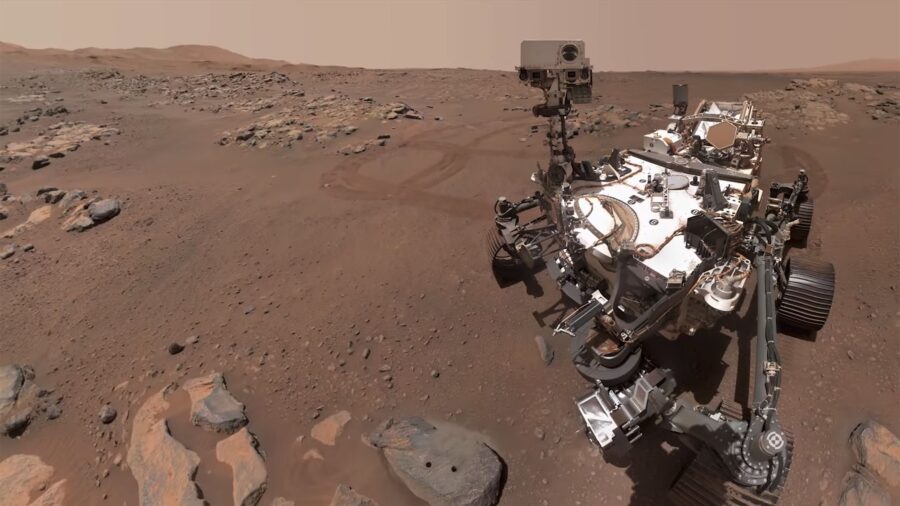A total lunar eclipse will turn the moon red. Here’s how to watch
May 13, 2022, 12:28 PM | Updated: Jun 8, 2022, 3:15 pm
(CNN) — May’s full moon will have stargazers seeing red.
The moon will glow a scarlet color during this year’s first total lunar eclipse on Sunday — a stark contrast to its ordinarily milky white sheen.
A partial eclipse will begin at 10:27 p.m. ET Sunday, with the total lunar eclipse starting at 11:29 p.m. ET, according to EarthSky. The total eclipse will end at 12:53 a.m. ET Monday, and the partial eclipse will end at 1:55 a.m. ET Monday, the site said.
A lunar eclipse occurs when the moon, Earth and sun fall into alignment, with the moon passing through Earth’s shadow, according to NASA. When the moon passes through the darkest part of the Earth’s shadow, called the umbra, it’s known as a total lunar eclipse, the space agency said.
When the sun’s rays reach the Earth, much of the blue and green light is scattered, while the orange and red colors remain visible, which is why the moon turns a reddish hue and is often referred to as the “blood moon,” according to The Old Farmer’s Almanac.
Not everyone will be able to catch a glimpse of the total lunar eclipse because it needs to be nighttime to see it, said Noah Petro, chief of NASA’s Planetary Geology, Geophysics and Geochemistry Lab.
People in South America and in the eastern part of North America will have a great view of the lunar eclipse, he said. The total lunar eclipse will be visible in much of Africa, Europe and South America and most of North America.
About two lunar eclipses occur each year, and the next will be a total lunar eclipse in November, Petro said. Then there will not be another total lunar eclipse until March 2025, he added.
How to view the eclipse
It is perfectly safe to view a lunar eclipse with your naked eye, according to Petro.
“That’s the great thing about lunar eclipses is that you require no other gear other than a passion and interest in being outside and a clear horizon,” Petro said.
For optimal viewing conditions, avoid bright lights and tall buildings that could obstruct your view, he said.
While the eclipse’s peak may only last for a short amount of time, the moon’s coppery tones will change throughout the night, according to Petro. These changes make this celestial phenomenon interesting to watch throughout the eclipse rather than at a particular moment, he said.
If it’s cloudy or the lunar eclipse is otherwise not available to view, you can watch a livestream of it from NASA.
There will be seven more full moons in 2022, according to The Old Farmer’s Almanac:
- June 14: Strawberry moon
- July 13: Buck moon
- Aug. 11: Sturgeon moon
- Sept. 10: Harvest moon
- Oct. 9: Hunter’s moon
- Nov. 8: Beaver moon
- Dec. 7: Cold moon
These are the popularized names associated with the monthly full moons, originating with Native American tribes. The names vary from tribe to tribe because a full moon had different significance across the tribes month to month or season to season.
Lunar and solar eclipses
In addition to one more total lunar eclipse in 2022, there will also be a partial solar eclipse, according to The Old Farmer’s Almanac.
Partial solar eclipses occur when the moon passes in front of the sun but only blocks some of its light. Be sure to wear proper eclipse glasses to view solar eclipses safely as the sun’s light can be damaging to your eyes.
A partial solar eclipse on October 25 will be visible to those in Greenland, Iceland, Europe, northeastern Africa, the Middle East, western Asia, India and western China. It won’t be visible from North America.
After this weekend, the next total lunar eclipse will also be on display for those in Asia, Australia, the Pacific and South and North America on November 8 between 3:01 a.m. and 8:58 a.m. ET — but the moon will be setting for those in eastern regions of North America.
Meteor showers
Check out the remaining nine showers that will peak in 2022:
- Southern delta Aquariids: July 29-30
- Alpha Capricornids: July 30-31
- Perseids: Aug. 11-12
- Orionids: Oct. 20-21
- Southern Taurids: Nov. 4-5
- Northern Taurids: Nov. 11-12
- Leonids: Nov. 17-18
- Geminids: Dec. 13-14
- Ursids: Dec. 21-22
If you live in an urban area, you may want to drive to a place that isn’t littered with city lights to get the best view.
Find an open area with a wide view of the sky. Make sure you have a chair or blanket so you can look straight up. And give your eyes about 20 to 30 minutes — without looking at your phone or other electronics — to adjust to the darkness so the meteors will be easier to spot.
The-CNN-Wire
™ & © 2022 Cable News Network, Inc., a WarnerMedia Company. All rights reserved.













